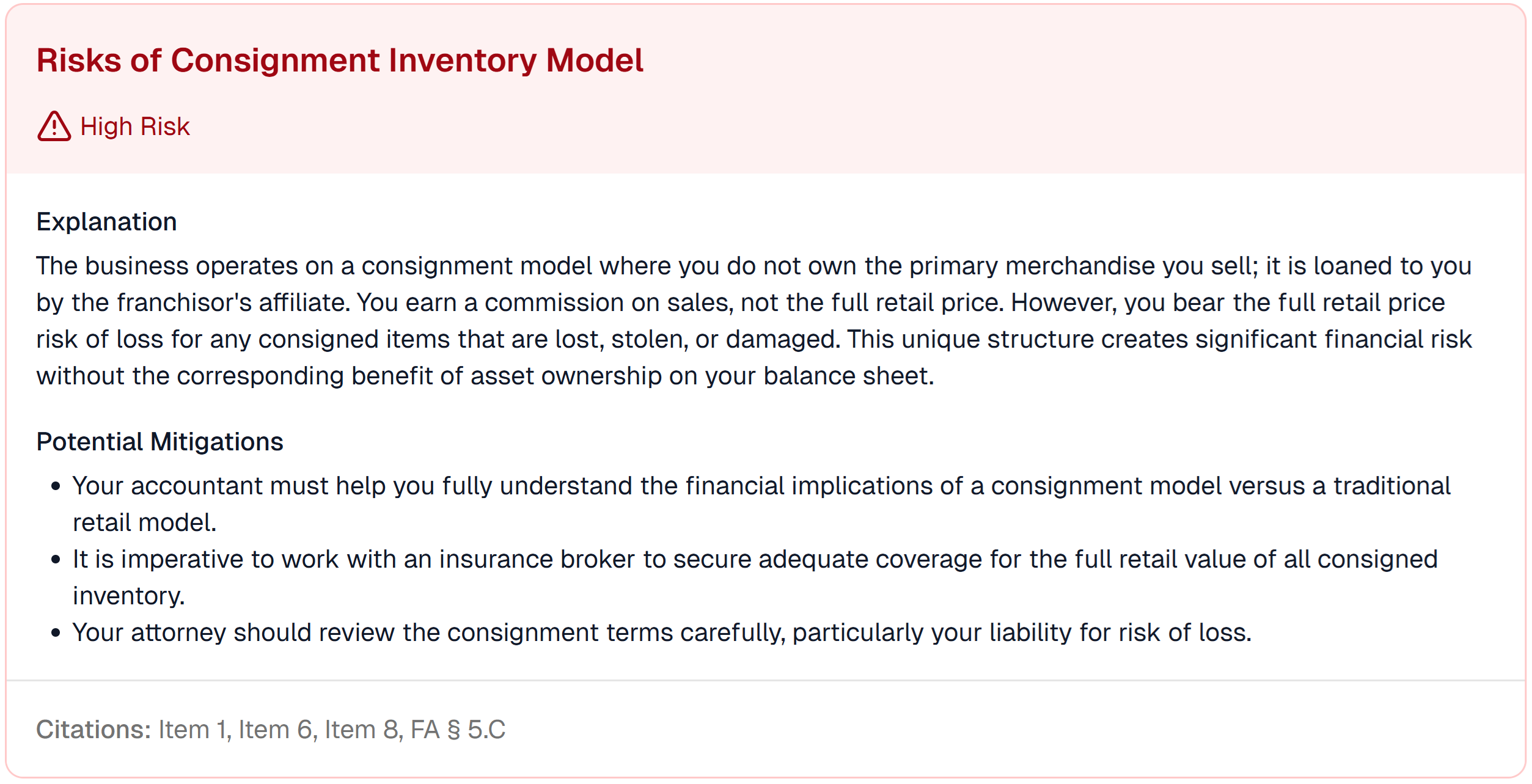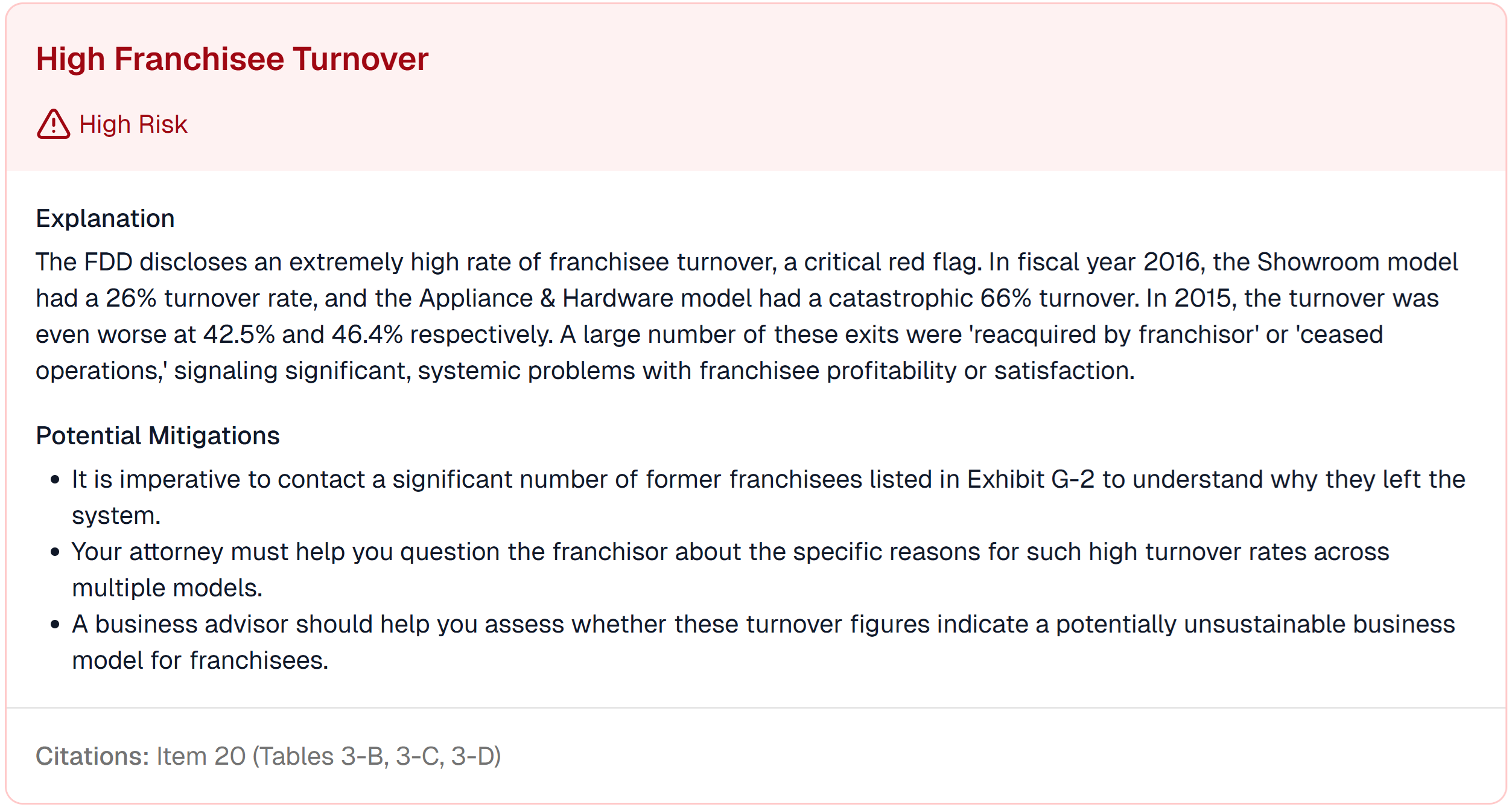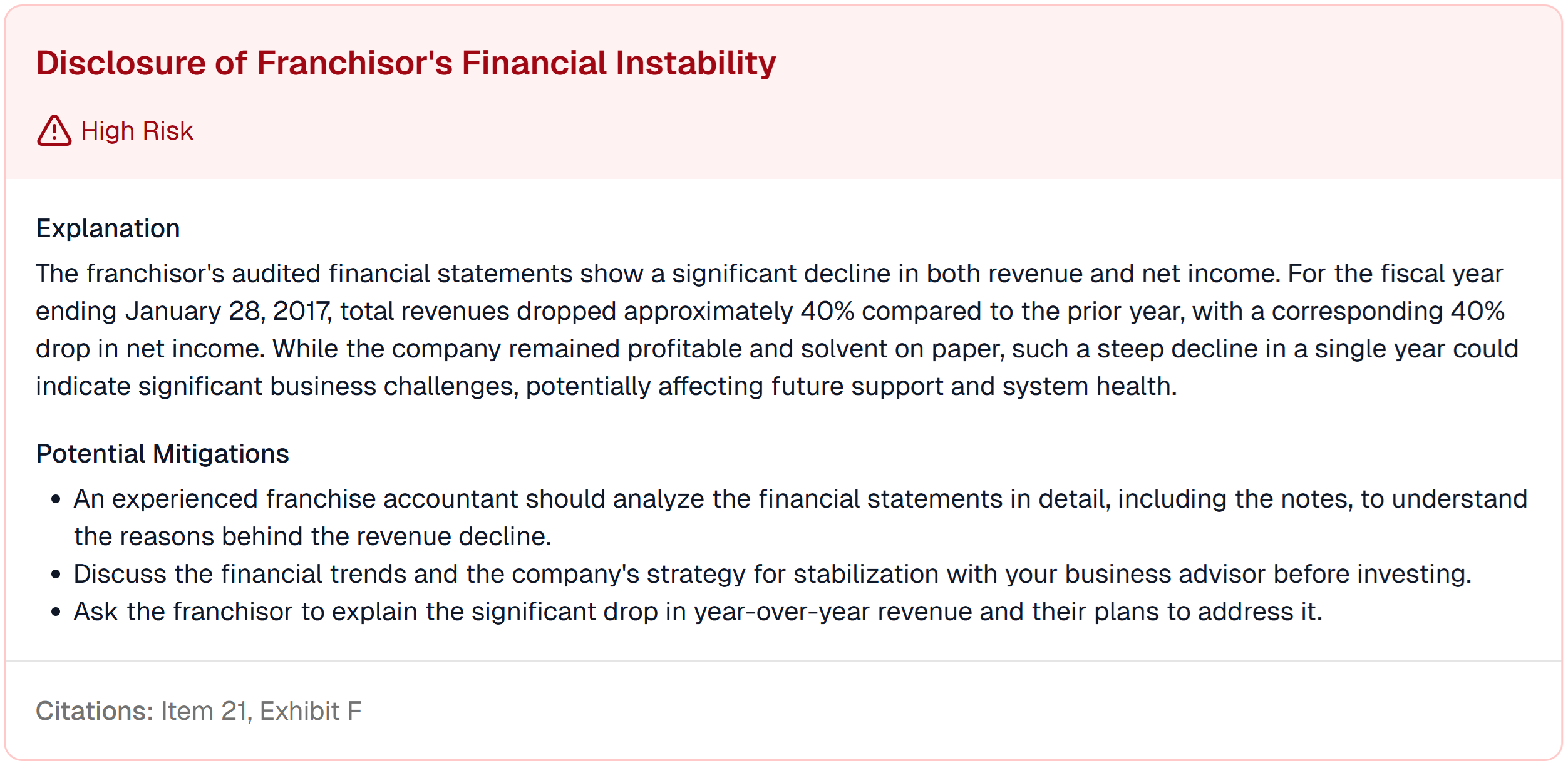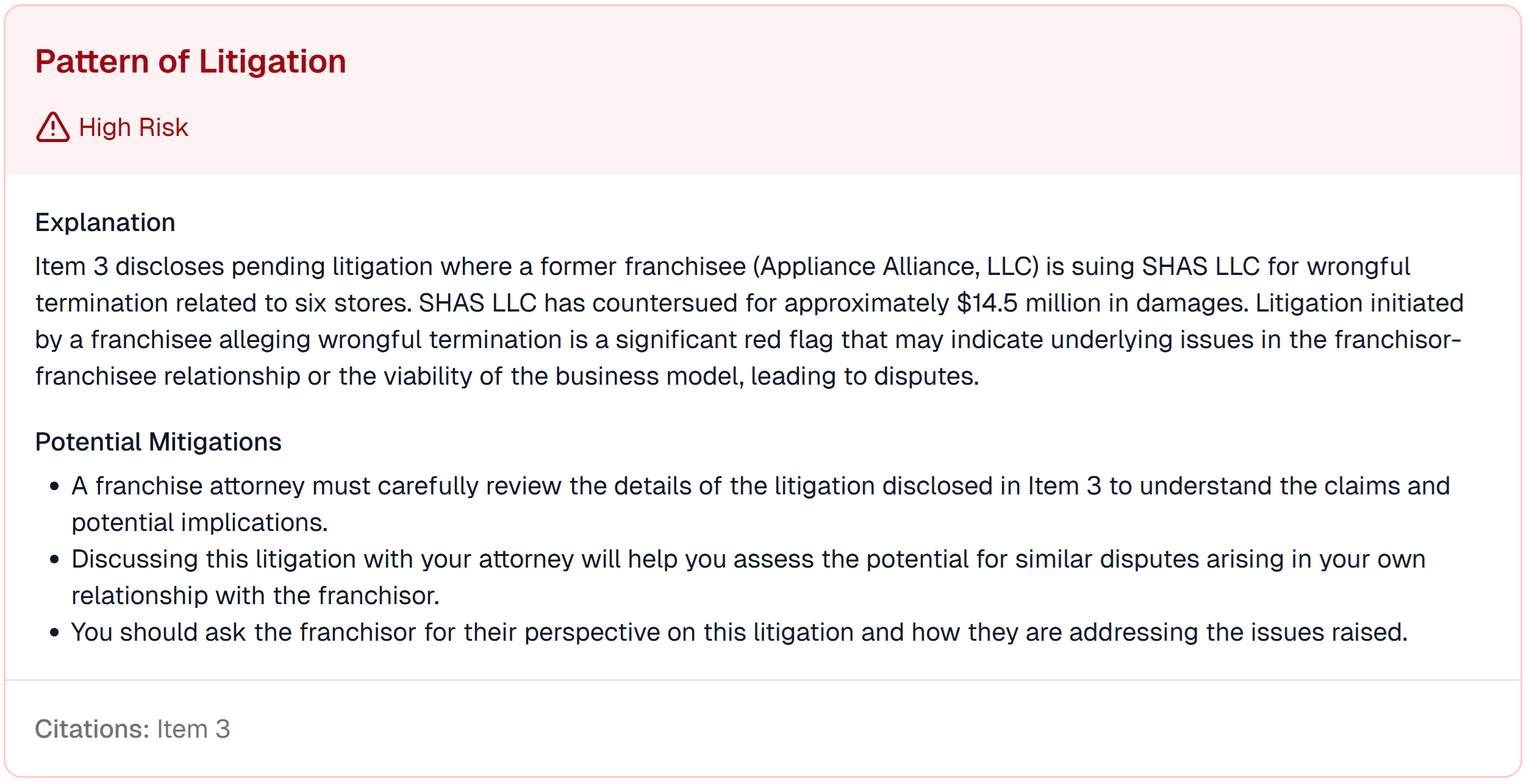
Sears Hometown Franchise Horror Story: How the 2017 FDD Warned of the 2022 Collapse
The dream of owning a local store backed by an iconic American brand – Sears – was compelling.
At its peak in 2014, the Sears Hometown system had around 1,250 locations.
For hundreds of entrepreneurs, however, that dream turned into a nightmare of empty shelves and dwindling profits.
By December 2022, the system had collapsed into Chapter 11 bankruptcy, liquidating its final 115 stores.
The fire-sale of an estimated $40 million in consigned inventory from showrooms—the very lifeblood of the remaining franchisees' businesses—left operators with devastating losses.
Was the Sears Hometown disaster foreseeable, even 5 years before the final collapse?
We ran the 2017 Sears Hometown Franchise Disclosure Document (FDD) Package—a 300+ page pdf containing the FDD, Franchise Agreement, and Exhibits—through our AI-powered FDD Risk Review process.
The full report is here, and the simulation was stark.
Half a decade before the 2022 public collapse, the 2017 FDD disclosed numerous high-severity warnings.
A prospective franchisee, equipped with the right analysis, could have used this information to ask the right questions of professional advisors and, hopefully, avoid the pain of a franchise catastrophe.
The Consignment Trap: All of the Risk, None of the Control
The most critical flaw our AI analysis uncovered was not just a single bad clause, but the entire business model itself.
The report flagged the unique structure of Sears Hometown as a High Severity miscellaneous risk, revealing a fundamental power imbalance that made the system uniquely vulnerable to collapse.

Explanation: The business operates on a consignment model where you do not own the primary merchandise you sell; it is loaned to you by the franchisor's affiliate. You earn a commission on sales, not the full retail price. However, you bear the full retail price risk of loss for any consigned items that are lost, stolen, or damaged. This unique structure creates significant financial risk without the corresponding benefit of asset ownership on your balance sheet.
Potential Mitigations: Your accountant must help you fully understand the financial implications of a consignment model versus a traditional retail model. It is imperative to work with an insurance broker to secure adequate coverage for the full retail value of all consigned inventory.
This was the mechanism of the disaster. Franchisees were responsible for 100% of a store's operating costs—rent, payroll, utilities—but had no ownership or control over the one thing that generated revenue: the inventory.
So when the franchisor’s own business faltered, it choked off the supply of goods, leaving store owners with high fixed costs, empty showrooms, and financial ruin.
The Writing on the Wall: A System in Freefall
The flawed consignment model was a tinderbox, and the 2017 FDD provided clear data showing the fire had already started.
Our AI flagged multiple High Severity risks that pointed to a system already unraveling.
An Exodus of Franchisees. The FDD’s Item 20 tables showed a shocking number of operators were already fleeing the system:

Explanation: The FDD discloses an extremely high rate of franchisee turnover, a critical red flag. In fiscal year 2016, the Showroom model had a 26% turnover rate, and the Appliance & Hardware model had a catastrophic 66% turnover. In 2015, the turnover was even worse at 42.5% and 46.4% respectively. A large number of these exits were 'reacquired by franchisor' or 'ceased operations,' signaling significant, systemic problems with franchisee profitability or satisfaction.
Potential Mitigations: It is imperative to contact a significant number of former franchisees listed in Exhibit G-2 to understand why they left the system.
A Failing Financial Foundation. The franchisor's own audited financials in Item 21 showed a company in a steep, dangerous decline:

Explanation: The franchisor's audited financial statements show a significant decline in both revenue and net income. For the fiscal year ending January 28, 2017, total revenues dropped approximately 40% compared to the prior year, with a corresponding 40% drop in net income. While the company remained profitable and solvent on paper, such a steep decline in a single year could indicate significant business challenges, potentially affecting future support and system health.
Potential Mitigations: An experienced franchise accountant should analyze the financial statements in detail, including the notes, to understand the reasons behind the revenue decline.
A Litigious Relationship. The conflict inherent in the model was already boiling over into high-stakes legal battles, a fact our AI flagged in Item 3:

Explanation: Item 3 discloses pending litigation where a former franchisee (Appliance Alliance, LLC) is suing SHAS LLC for wrongful termination related to six stores. SHAS LLC has countersued for approximately $14.5 million in damages. Litigation initiated by a franchisee alleging wrongful termination is a significant red flag that may indicate underlying issues in the franchisor-franchisee relationship or the viability of the business model, leading to disputes.
Potential Mitigations: A franchise attorney must carefully review the details of the litigation disclosed in Item 3 to understand the claims and potential implications.
The One-Sided Deal
Beyond the flawed model, our AI's analysis of the Franchise Agreement found numerous terms that shifted nearly all risk onto the franchisee, including these High Severity risks:
-
Franchisee's Unlimited Personal Guaranty: The FDD required owners to sign a broad personal guaranty, bypassing any LLC protection and putting their personal assets—home, savings, and more—on the line for all business debts.
-
Liability for Future Royalties: If terminated, you were required to pay "Lost Revenue Damages." This could result in a massive, immediate payment obligation at the precise moment your business failed.
-
Forced Asset Sale at Termination: The franchisor had the option to buy your store's assets at "book value" using straight-line depreciation. This method almost guarantees a purchase price far below fair market value and explicitly excludes any payment for goodwill, meaning you get nothing for the customer base you built.
Don't Let This Be Your Story
The collapse of Sears Hometown was a tragedy for hundreds of families who had invested in a brand-name dream.
The warning signs of disaster weren't hidden in secret documents, though.
With the right tools, they could have been found in the 2017 FDD years before the franchise's ultimate demise.
With today’s technology, we've built such a tool.
Before investing in any franchise, optimize your consultation with your trusted franchise professionals.
An AI-powered FDD Risk Report provides critical, data-driven insights to help you to ask the right questions, and protect your future. Get Your FDD Risk Report Today.